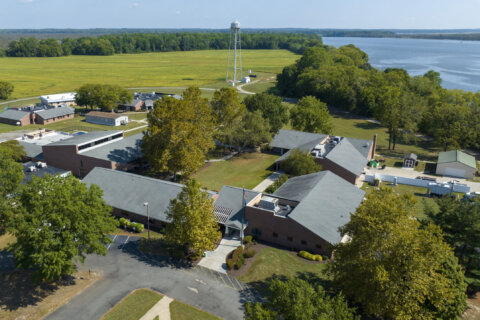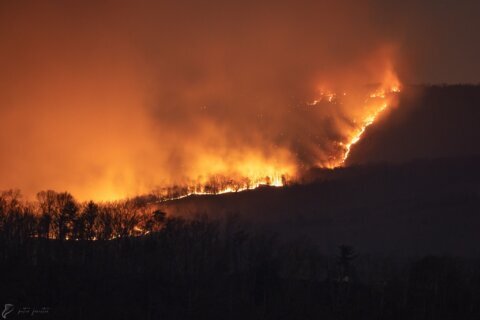This article was republished with permission from WTOP’s news partner InsideNoVa.com. Sign up for InsideNoVa.com’s free email subscription today.
This article was written by WTOP’s news partner InsideNoVa.com and republished with permission. Sign up for InsideNoVa.com’s free email subscription today.
On Tuesday morning, Alex Friedman and a handful of other passengers watched their northbound Virginia Railway Express train pull into the Woodbridge station right on time. He was taking it to L’Enfant Plaza in Washington, where he would disembark and go to his engineering office in the city.
On the current “special” weekday schedule, only 18 trains service the Fredericksburg and Manassas lines, down from 32 before the COVID-19 pandemic. Ridership is about 90% below pre-pandemic levels.
Incidentally, the system’s on-time performance has never been better, the result of having fewer trains on the rails and fewer passengers to board. In December, on-time performance hit 96%, up from 85% in December 2019.
Friedman says the lower ridership (and reduced capacity for every train) has made his morning commute even better. While he used to go into the office a minimum of four times a week, Friedman says he now usually goes in only two or three times, working the rest of the week from home.
“I get my pick of seats,” he said. Asked whether he feels safe, Friedman said yes. “We’re all spaced out and wearing masks.”
VRE leaders hope more people will feel the same way once COVID-19 vaccines have been distributed widely enough for offices to reopen, but they admit they don’t know how commuting patterns might be permanently altered by the pandemic. Even Friedman said he’s not sure he’ll go back to his old routine.
In its proposed 2022 budget, VRE staff acknowledged how little certainty there is regarding future ridership, declining to include a typical six-year forecast of expenses and revenues.
“The projection is intended normally to demonstrate the sustainability of VRE’s budget and to highlight areas of potential risk so that they can be addressed in advance,” said Mark Schofield, the system’s chief financial officer. “Doing a forecast like this at this moment would include highly uncertain estimates on a number of variables, particularly including ridership.”
VRE officials remain confident in the system’s financial health, buoyed by over $86 million in federal CARES Act funding that will be used to plug holes beyond the fiscal year 2022 budget. Typically, VRE has a goal of recovering half of its operating expenses through fares, but in the past year the system has earned just 10% of those expenses back. As a result, VRE used $2.7 million of CARES money to balance its fiscal year 2020 budget and $32 million for the current budget. Next fiscal year, it expects to use just under $25 million.
More federal money could be on the way. The most recent version of the COVID relief package being negotiated in Congress allocates $30 billion for transit systems, $5 billion more than the CARES Act. VRE has also seen some smaller savings in other areas. Fewer ticket sales has meant lower bank processing fees. And the cost of diesel fuel fell precipitously in 2020 and remains below pre-pandemic levels. As a result, the proposed operating budget for next fiscal year is about $1.7 million lower than the last.
Rich Dalton, who became permanent CEO of VRE in September, says the system is ready to return to its 32-train weekday schedule as soon as demand picks up. Staff projects that ridership will increase to about 6,000 daily riders by July 2022 but acknowledges that is something of an educated guess. And even that number is only about a third of the roughly 18,000 average daily riders that trains carried in 2019.
“We feel that we’re going to gradually pick up ridership. But it’s going to be 12 to 18 months before we really not just recover a large portion of the ridership that we had before but also to get to what that new normal looks like,” Dalton said. “With our FY 2022, we budgeted based on an average daily ridership of about 6,000 riders, and that’s being pretty conservative of course. We would anticipate that more so on the latter part of FY 22.”
Dalton is confident that even if commuting patterns change after COVID, commuter rail will still be integral to the region’s workers and its economy at large.
His staff is already working on the massive $3.7 billion project to expand VRE and Amtrak service in Northern Virginia by 2030 through, among other things, the construction of a new Long Bridge across the Potomac River. As part of the deal, announced in December 2019, VRE will add additional round trips on weekdays, weekend service and reverse-commuting service.
Over the summer, VRE and the Virginia Department of Rail and Public Transportation jointly stood up the new Virginia Passenger Rail Authority, which is currently overseeing design work on the project.
In the meantime, Dalton says, the focus is on maintaining safe and efficient service for existing passengers and those who will return when the pandemic subsides, even on a different schedule.
The Northern Virginia Transportation Commission has launched a marketing campaign featuring digital and radio ads touting safety measures being taken on the region’s public transit networks. “Throughout these challenging times, Northern Virginia’s trains and buses continue to get you where you need to go,” the radio ads say.
“Maybe one of the changes is folks would be teleworking two days, maybe three days per week, something like that. So maybe the number of our peak days during the week would reduce,” Dalton said. “But we still have to build the service to make sure that we’ve got the capacity for the peak.”







